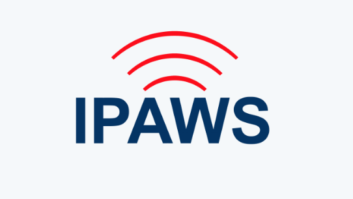NAB2003 in review
Jun 1, 2003 12:00 PM, By Chriss Scherer, editor
Another year goes by and another NAB convention comes and goes. Following months of preparation, everything comes together for a few days in Las Vegas. Now that it’s all over, exhibitors and attendees have plenty to absorb and review.
During and after a convention, the most common question I hear is, “what did you see?” Once again, the answer was, “plenty!” But with this response comes clarification. While there were many new product introductions this year, I felt that the new product introductions for the most part could be described as evolution and not revolution. There was new technology, but most of what was shown consisted of upgrades, updates, new versions and enhanced features.
The convention-floor traffic showed lots of activity on the first days.

Evolution is a natural process, and given the current economic state, companies are focusing on ways to improve their products to preserve their own business structure. A completely new design from the ground up can be an expensive proposal. Manufacturers are smart to work within conservative margins for now, saving the revolutionary developments for next time.
Better, stronger, faster
Creating a product with an enhanced feature set, smaller size and sometimes a reduced price was a familiar theme at the convention. This fits in perfectly with the evolution not revolution concept.
Few people at a station build anything themselves today. What was once a project for some spare time is likely available from a manufacturer. Circuitwerkes, Radio Design Labs, Henry Engineering and Broadcast Tools are some examples of companies that have created unique solutions to niche problems.
A dominant example of enhanced performance could be seen in the on-air audio storage and playback systems. While we have called them automation systems for years, they are moving beyond file-server functions and becoming facility-wide event controllers as well. In a short time, this technology has matured into a highly developed and competitive arena. On-air storage and playback systems were omnipresent with software revisions and new versions.
One of the more popular features that was shown in several systems is the ability to store program-associated data in addition to the audio file. This information can be accessed by the on-air talent to provide instant relevant information, but in a broader capacity, this data can be used to update a variety of systems, such as a station’s website, an RBDS display, and soon enough an IBOC radio display.
SAS demonstrates the Rubicon to several onlookers.

In a related way, Stratosaudio was showing its progress in providing an interactive element for listeners to obtain more information about on-air content as well as a method to facilitate music purchases.
More features and niches
While automation systems have advanced as a whole, individual manufacturers continue to find ways to differentiate themselves. RCS is looking ahead to IBOC by including PAC-ST encoding to its Master Control file format list. PAC-ST is the studio version of the PAC encoding algorithm used by Ibiquity Digital in its HD Radio system. Scott Studios unveiled Stretch and Squeeze, a feature that can dramatically change the length of a recorded element without introducing unwanted audible artifacts.
Enco showed Enteractive, which is a method for listeners to provide feedback or even playback control.
Dalet debuted the Media Asset Library, a method of organizing and retrieving massive amounts of data.
Netia, which is now distributed in the U.S. through Turnkey Media Systems of Olathe, KS, continues its evolution of Radio-Assist 7. Prophet demonstrated the recently released Nexgen version 2.0, and already has plans for version 3.0 in the works. BSI also released a new version of Simian.
Broadcast Electronics has added the Main Program Service specification to the Audiovault systems to handle radio-display data, as well as complete MP3 support and a MIDI control feature to connect to outside sources.
Cartworks and Pristine Systems have completed their merger and were showing the CDS-32 system.
Not big for IBOC
Earlier this year, Ibiquity Digital began its heavy push that IBOC was here and that consumer radios would be shipping this summer. It was expected that IBOC, branded HD Radio by Ibiquity, would have a dominant presence at the convention. It turned out that IBOC made a presence, but not as dramatically as I expected it to be.
Logitek unveiled enhancements to its console/router system.

Several transmitter manufacturers displayed new IBOC offerings. With more stations making the transition every day, there were bound to be new transmitters on the floor. Broadcast Electronics, Harris, Nautel and Armstrong showed solid-state designs. Broadcast Electronics also unveiled the FM-25T single-tube transmitter.
One twist was from Continental Electronics. It is a common but untrue belief that a tube transmitter cannot work with IBOC. A few examples have been shown in the past, but one popular tube design showed the technology again when Continental Electronics modified an 816R transmitter to transmit a hybrid IBOC signal. While more of a concept � and operating at a reduced efficiency � the intent was to show that it is possible.
The antenna manufacturers showed their current work in interleaved separate antennas, separate-feed panels and alternate combiner methods, such as the Shively system in use by Entercom Seattle.
IBOC is not the only game in town when it comes to transmission. Solid-state transmitters continue to shrink in size and grow in power. Armstrong Transmitter and Delta RF Technology both showed solid-state designs that deliver several medium power levels in a small rack space. This trend in physical size and power efficiency will continue for some time.
Processing for digital
The audio processing competition goes on as manufacturers continue to develop their digitally based designs. Because these digital approaches are designed on building blocks, manufacturers are finding ways to offer new products that fill a variety of spaces. For example, Orban unveiled the Optimod 8300, which offers an incremental step to digital processing in the Orban line.
Attendance was down, which gave attendees more quality booth time.

Omnia, who already has several offerings in scale for digital processors, unveiled the Omnia 6-HDFM, which provides a dual-output system to feed separate analog and digital paths while using a single front-end controller.
Traditional audio processing for distribution over a data-reduced channel presents a potential problem. Aggressive processing significantly reduces the dynamic range, which makes it difficult for a perceptual audio encoder to find the maskable elements that can be discarded to reduce the payload. Harris demonstrated the Neustar, which is based on neural network audio processing, as a way to pre-process audio prior to encoding in an effort to enhance codec performance.
The year of the console/router
Without a doubt, this was the year for integrated console and router designs to flourish. The technology, first introduced several years ago by Logitek and Klotz and later Computer Concepts, integrates the roles of audio routing, level control and machine function into a single system. In some cases, the console is nothing more than a sophisticated control head.
The existing systems have evolved from their large-system applications to be a viable alternative even for small installations. The radio industry has responded by installing more of these systems, embracing the power and flexibility they provide.
Existing manufacturers that provided the console or the router element have been looking at ways to cross the barrier to the integrated side.
Ibiquity demonstrated a multi-channel broadcast system.

Wheatstone for a long time has held a distinguished spot in the console realm. Two years ago, the company introduced the Bridge router, which has grown in popularity. To solidify the relationship between the console and router, Wheatstone debuted the Generation-4 and Generation-9 control surfaces, which provide a fully integrated approach.
Following its acquisition of Pacific Research and Engineering, Harris moved to a prominent position in the console market. Harris has added Vistamax, a routing and control engine that works with BMX Digital and Vistamax-enabled consoles.
SAS, who has held a leading position in audio routers for many years, has entered the console realm from a different angle. Starting with the company’s 32KD digital audio router, the Rubicon control surface completes the console approach.
The AEQ BC-2000 provides a platform capable of routing up to 2,048 by 2,048 sources and destinations. The systems ties into the company’s E@sy control network.
One final and somewhat different approach was exhibited by Telos. The Livewire system uses traditional Ethernet hardware to route and manipulate IP-encoded audio. Audio sources are converted to IP through dedicated hardware converters.
The final word
Overall, the convention was a good experience. The conference sessions provided interesting presentations and the convention floor offered introductions to new technology. The overall attendance was down from previous years; a fact that could be attributed to the general economy, the pending (at that time) conflict in the Middle East, and international health issues. Most exhibitors had the same story: they experienced an audience of quality and not quantity. This has become a tired phrase, but it still seems to be accurate. However, given the current trend, at some point we will see a diminished quantity of that quality audience. In the meantime, the convention attention turns to the NAB Radio Show.
The Radio magazine NAB2003 coverage also includes the Pick Hits on page 34 and the NAB Jackpot on page 64. With so much new product news from the convention, look to upcoming issues of Radio magazine � and especially our annual Product Source this summer � for more new product introductions.











